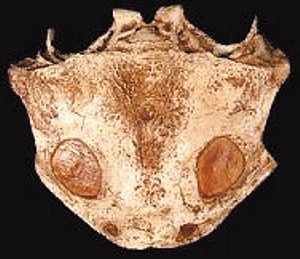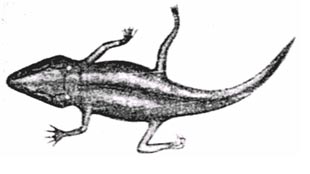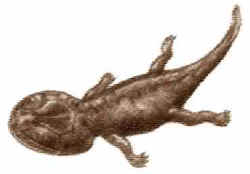
| Palaeos: |  |
Temnospondyli |
| The Vertebrates | Rhytidosteids & Brachyopoids |
| Page Back | Unit Home | Unit Dendrogram | Unit References | Taxon Index | Page Next |
| Unit Back | Vertebrates Home | Vertebrate Dendrograms | Vertebrate References | Glossary | Unit Next |
|
Abbreviated Dendrogram
TETRAPODA |--+--LEPOSPONDYLI | `--REPTILIOMORPHA | TEMNOSPONDYLI |--Edopoidea `--+--Dvinosauria `--+--Euskelia | |==Dissorophoidea | | `--LISSAMPHIBIA | `--Eryopoidea `--Stereospondyli |--Rhinesuchidae `--+--Lydekkerinidae |--+--Plagiosauroidea | |--Laidleriidae | `--+--Rhytidosteidae | `--Brachyopoidea | |--Chigutisauridae | `--Brachyopidae `--+--Capitosauria `--Trematosauria |--Trematosauroidea `--Metoposauroidea |
Contents
Index |

From Adam Yates's blog Dracovenator: More temnospondyls: old big eyes from the Moenkopi ( Tuesday, December 23, 2008 ):

Batrachosuchus, a classic brachyopid from the Early Triassic of South Africa. (Wikipedia) |
Among the Triassic temnospondyls are the enigmatic brachyopids. Brachyopids present a classic case of the difficulty in disentangling convergence from relationship in an extinct group. Their shortened parabolic skulls bear more than a passing resemblance to another group of temnospondyls, the dvinosaurs (dinosaurs are good but a dvinosaur is devine – sorry, couldn't resist) and indeed the consensus opinion is that brachyopids are the derived descendants of earlier dvinosaurs.

Dvinosaurus, a dvinosaur from the Late Permian of Russia. (Wikipedia) |
However brachyopids share some unusual derived characters with other derived temnospondyls from the Triassic known as stereospondyls. Some of these characters include: a double occipital condyle; the pterygoid bone in the palate forms a long broad suture with braincase rather than a narrow synovial contact; and lack of exposure of the opisthotic in the occiput. I took this to mean that brachyopids really were stereospondyls and share a more recent common ancestor with long snouted stereospondyls like Paracyclotosaurus than they do with short snouted dvinosaurs like Dvinosaurus (right), or rather that is what I found in my cladistic analysis that I performed for my PhD thesis, later published with my supervisor, Dr Anne Warren. This kind of ecophenotypic convergence seems to have happened multiple times in the evolution of crocodile snout shape (though maybe a little less than previously thought if false gavials and gavials really are sister taxa) and seeing it in temnospondyls was almost to be expected. Of course the situation isn't quite so simple, for instance some late surviving incontrovertible dvinosaurs do develop some of the stereospondyl synapomorphies convergently (even more disconcerting is that they develop them at the same time that the streospondyl lineage does!). So it really maybe the case that it is the unusual and apparently unrelated features of stereospondyls that are the convergences while the broad trophic adaptations such as snout shape are a true indication of relationship. It's a wonderfull and truly juicy puzzle that I once wanted to tackle myself, but I'm so thoroughly bogged down in dinosaur projects now that I can't see myself getting to it anytime soon. Furthermore the travel involved in unraveling this tangle is pretty daunting. Significant fossils are scattered all over the globe, with important specimens in many parts of the US, England, Argentina, South Africa, Australia and Russia. So for now I am happy to sit back and watch the progress from the sidelines. One researcher who has really picked up where I left off is Marcello Ruta. Marcello hasn't solved the problem yet but he has started really squeezing more phylogenetic information out of temnospondyl fossils than I ever did.
One little step on the road to understanding brachyopids has just been published by Marcello together with John Bolt of the Field Museum. They looked at Hadrokkosaurus bradyi a large brachyopid from the Moenkopi Formation of the US and one of the better known brachyopid names. The name Hadrokkosaurus means"big eyed lizard" and the skull disseminated around the world in the form of casts truly does have big goggling orbits.

The famous skull, referred to Hadrokkosaurus. |
It comes as a surprise to many, myself included, that this famous skull isn't the holotype. Indeed the holotype doesn't even preserve orbits at all,for it is an isolated lower jaw ramus. Furthermore this lower jaw was found over 100km away from the skull. With a name like Hadrokkosaurus it is hard to dispute that the Welles had the skull in mind when he erected the name. However the jaw was found first and originally named Taphrognathus, which was unfortunately preoccupied by a conodont (not an arthropod for once!). Thus Hadrokkosaurus was created to replace Taphrognathus, leaving the lower jaw as the holotype specimen. This is a pity and it has created a messy taxonomic situation. Jupp and Warren suggested way back in 1986 that the lower jaw might not belong to the skull, and might not even be a temnospondyl at all! They cited the presence of an external mandibular fenestra, teeth that are partially sunk into sockets, weak surface ornamentation, a splenial bone that does not participate in the symphysis of the jaw and a surangular-prearticular contact behind the jaw joint, to suggest that the jaw is infact an archosaur (archosauriform in recent classifications). I need not remind you that a pair of roundned lower jaws fitting onto something roughly the size and shape of a dustbin lid makes for a pretty unusual archosauriform, particularly one of proterosuchian grade with subthecodont teeth. Because of the uncertainty surrounding the identity of the type jaw Anne Warren and Caudia Marsicano decided to bestow a new name upon the well-known skull, they called it Vigilius wellesi. The genus name means 'watchfull' or 'vigilant' and sort of echoes the original 'big eyed lizard'. The species name obviously honours Samuel Welles, the original describer of Hadrokkosaurus.
So is Hadrokkosaurus a weird-ass archosauriform? Definately not: Ruta and Bolt demolish any chance that these jaws belong to an archosauriform. The jaw shows some additional primitive bones (three coronoid bones, and two splenial bones) that are not found in any crown group amniotes, let alone in archosauriforms.
So its not an archosauriform what is it? Well it is without doubt a brachyopid after all. The so called un-temnospondyl like features are either artefacts of damage or misinterpretation (e.g. the so-called external mandibular fenestra) or are derived characteristics that are present in other temnospondyls (e.g. reduced ornamentation of the bone surface, subthecodont teeth and failure of the splenial to reach the symphysis). Furthermore a number of other characteristics, most obviously the honking big retroarticular process, are fairly convincing synapomorphies of Brachyopidae.

The skull of Vigilius (left) and the jaws of Hadrokkosaurus (with the right side mirrored) on the right. Taken from Ruta and Bolt 2008. |
So are Vigilius and Hadrokkosaurus the same thing after all? I think they probably are, although Ruta and Bolt suggest that they may be two different brachypoids on the basis of non-matching jaw curvature. However we are dealing with different individuals of different sizes in a taxon that did not have precise occlusion in any case so slight differences in jaw curvature not convince me that they are distinct. Indeed both the lower and upper jaws seem to me to have slightly squared-off tips and angular margins that differ ever so slightly from the typical parabolic jawlines of most other brachyopids. This observation coupled with the highly reduced ornamentation of both Vigilius and Hadrokkosaurus (extreme even for brachyopids) and their occurence in the same formation leads me to suspect that the two taxa are indeed the same. We'll just have to wait to find a skull with jaws included to prove it.
Apart from clearing up the identity of Hadrokkosaurus, Ruta and Bolt 2008's paper is important because it demonstrates that a great deal of phylogenetic information can be gleaned from the lower jaws. They analyse lower jaw characters alone and recover a topology that has much in common with my own (there is some weirdness but what do you expect from analysing just one organ system?). In contrast my analysis included a paltry 14 lower jaw characters and probably would only be able to resolve a couple of nodes, if any at all, if run by themselves. That's a whole lot of information that shouldn't be ignored.
Copyright Adam Yates © 2008, republished with permission
 Rhytidosteidae:
Acerastia, Acadia, Deltasaurus, Derwentia, Nanolania, Peltostega,
Pneumatostega, Rewana, Rhytidosteus.
Rhytidosteidae:
Acerastia, Acadia, Deltasaurus, Derwentia, Nanolania, Peltostega,
Pneumatostega, Rewana, Rhytidosteus.
Range: Late Permian to Early Triassic worldwide.
Phylogeny: Trematosauria:::: Brachyopoidea + *.
Characters: Skull triangular, with straight sides; lacrimal absent; $ transversely short, triangular condyles on quadrate without median sulcus [Y00]; otic notch shallow; broad cultriform process; quadrate ramus of pterygoid not "twisted"; $ body of pterygoid, palatine ramus of pterygoid, vomers, cultriform process & anterior 2/3 of parasphenoid covered with dense field of denticles [Y00]; denticles lateral to dentary tooth row; teeth absent from coronoids; tusks on anterior ectopterygoid.
Links: Temno.htm; Lydekkerinidae/ Rhytidosteidae; Untitled Document; amphibians; TRIÁSSICO INFERIOR.
References: Yates (2000). ATW020820.
Range: Early Triassic to middle Cretaceous
Phylogeny: Trematosauria:::: Rhytidosteidae + *. Chigutisauridae + Brachyopidae. ATW000420.
These were short-headed semi-aquatic forms, they flourished during the Triassic. A few survived into the Jurassic and Cretaceous and grew to quite large size. MAK010417.
 7 metre long Brachyopoid. Illustration by A. Beneteau (original url) |
Representatives of several clades of temnospondyls reached huge size. These included the 9 meter long gavial-like Prionosuchus, an Archegosaurid from the Permian), and the 6 meter-long Mastodonsaurus (a middle Triassic Capitosaur). The illustration above shows a giant brachyopoid from the Latest Triassic or Early Jurassic of Lesotho, estimated to have been some 7 metres in length, which dwarfs previous known giants of this clade such as Siderops and Koolasuchus (botha round 2.5 meters). A small fragment of a skull, just 22 cm long, was found in 1970 by a French Expedition near Alwynskop in Quthing District (Summary of events in Lesotho). Initially considered a mastodonsaur because of its size, it was redescribed by Steyer and Damiani, 2005 and found to be a Brachyopoidea (Brachyopidae + Chigutisauridae sensu Warren and Marsicano [2000]) based on its dental morphology, presence of a well-developed ectopterygoid tusk, and the concavity of the ventral margin of the skull in lateral view. (abstract)
MAK090724
Chigutisauridae: Keratobrachyops, Koolasuchus, Siderops. The last temnospondyls.
Range: Triassic? to middle Cretaceous.
Phylogeny: Brachyopoidea: Brachyopidae + *.
 Brachyopidae:
Banksiops, Batrachosaurus, Batrachosuchoides, Batrachosuchus, Blinasaurus,
Brachyops, Gobiops, Notobrachyops, Platycepsion, Sinobrachyops, Vanastega,
Vigilius, Xenobrachyops.
Brachyopidae:
Banksiops, Batrachosaurus, Batrachosuchoides, Batrachosuchus, Blinasaurus,
Brachyops, Gobiops, Notobrachyops, Platycepsion, Sinobrachyops, Vanastega,
Vigilius, Xenobrachyops.
Range: Triassic? to Late Jurassic.
Phylogeny: Brachyopoidea: Chigutisauridae + *.
The Brachyopids were a group medium-sized tetrapods characterized by short, broad flat skulls with large eyes situated far forward. The legs are relatively small; the creature would have spent most of its life in streams and lakes, although it may have been quite capable of moving about on land. The upper margin of the mouth was armed with large fangs, indicating fish-eating habits. The different species are distinguished mainly by details of skull shape. MAK000208.
Links: A phylogeny of the Brachyopoidea (Temnospondyli, Stereospondyli) (abstract); amphibians (range data); JVP Content; Some Amphibian and Reptilian Remains (1859) (historical importance of Brachiops); Dinosaur museum (Sinobrachiops image and Chinese text); TRIÁSSICO INFERIOR. ATW031120.
| Page Back | Unit Home | Page Top | Page Next |
checked ATW050530